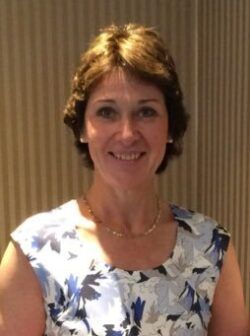Lessons in leading a network: an interview with Fiona Campbell
We caught up with the National Children and Young People’s Diabetes Network clinical lead, Fiona Campbell, to learn more about her network leadership style and explore how the network has been developing over the last few years.
Fiona Campbell is a consultant at the Children’s Hospital in Leeds who has practised in the NHS for 40 years. She has chaired the Children and Young People’s Diabetes National Network since 2019. It is made up of regional networks across England and Wales who work together to improve the quality of services for children and young people with diabetes.
Reflecting on your time leading the network, what are you proudest of?
I am proud of the quality improvement programme that we ran at the Royal College of Children and Young People over the last five years. It has given every diabetes team in the country an opportunity to understand quality improvement, to be peer reviewed and to look at and learn from their quality data. It has enabled them to feel responsible for using their data to drive change.
My role has been to make sure all the players are playing to tune and that we do all we can to work towards our key outcome: improving the lives of children and young adults to live with diabetes.
What makes leading in a network different?
It requires an inclusive leadership style. It’s about taking on board people’s views, listening to them and understanding their point of view, and getting them to come on board using everyone’s feedback.
What have been your biggest challenges?
You need to keep revisiting similar conversations because new staff join and you need to keep educating and re-educating people. So it’s been a challenge to make sure everybody understands where we’ve come from and where we would like to go.
Funding is going to become much more of a challenge and that will be much more difficult to overcome. However, we’re in good conversation now with NHS England. In England, there is an oversight board for children and young adult diabetes and I’m part of it as our network representative.
Our strategic direction is linked to the NHS England agenda and we’re working together at a strategic level. But our biggest barrier is going to be NHS England providing resources to take forward our ideas.
The Network shares good practice and sets high-quality standards for the care of children and young people with type 1 diabetes. What supports your progress?
We’re firmly focused on children, young people, young adults and families to live the best life they can with diabetes. That mission still stands. We started small and got everyone on board. And we’ve got more and more people interested, and the movement has grown bigger. Big enough to attract NHS England’s attention and funding and hopefully we can continue with their support.
Looking at the National Paediatric Diabetes Audit (NPDA) data, we can see improvements in outcomes. We’ve also had more of a focus recently on Type 2 diabetes. The importance of driving outcomes is high and because we’ve done well in the past, it’s attracted attention and support to do better in the future.
What components drive the network?
We’re about three years into our delivery plan about standardisation – it was about the involvement of patients and funding and encouraging leadership.
Funding is fundamental. We can’t do anything without the money. How best we use the limited resources available remains a focus for us.
Although the quality improvement programme has come to an end, we’re discussing with NHS England what our next phase of quality improvement and assurance might be. We’re looking at a combined programme with The Royal College of Paediatrics and Child Health, possibly moving into the Getting it Right First Time (GIRFT) programme that exists for adults with diabetes to extend their remit to include children so that we have an all age GIRFT.
Patient participation is an area we are interested in, and the development of peer networks of support. We’ve been doing work in conjunction with the HIV family networks of support and we’re starting an intervention in Leeds and in London to introduce a model of peer network support for families. I’m keen to now focus on family engagement, family peer networking and supporting families to live well with the condition.
You need to develop other leaders because you’re not going be around forever.
I’ve focused on sub-network development where people with a special common interest in an area from different regional networks come together. Now we’ve got a national psychology network, one for youth workers and one for our nursing colleagues. This is about finding people with special interests and developing their leadership skills. Much more of the work is being done by all my colleagues, which is really lovely to see.
Culture is so important for collaboration and networks. How would you describe the network’s culture? And how do you foster it?
The quality programme helped enormously to get everyone working together, to get people sharing good practice. Encouraging communication with each other, whether in good times and not so good times.
Improving communication takes away any suspicion that you’re trying to gain on your colleagues. It’s important to work together on a specific aim, share the national data and celebrate success together.
The NHS England diabetes team came on board to help, so there’s been a collaborative approach to agenda setting and fostering good relationships. At the end of the day, we’re all trying to achieve the same thing, albeit in slightly different ways. We’ve built a really successful network over the years, I’m desperate that it continues and gets better.
How do wider diabetes systems, organisations and professional groups impact on the network?
I’m very protective of the Children and Young People’s Diabetes Network. There was always an anxiety that NHS England would swoop in and take us apart or replace all our efforts. However, with a lot of active dialogue and reassurance to our network, we’ve taken away these fears. We make sure that not one patient is disadvantaged by the slight differences. If you look at a map of the seven NHS England regions and ours, there is not much difference.
At integrated care system (ICS) level, we can fit the ICSs into our geographical picture quite tidily. I take part in the integrated care board to Network interface. We have a lovely model in the Yorkshire and Humber region, where we have one network manager in the region and three ICSs, and we make that work. There are slightly different models in the Midlands, London, the South East and the South West, but they are working and people are communicating in the way that their geography allows best.
Participate actively, don’t hide your light under a bushel.
The challenge is when diabetes messaging goes out for children and young people but doesn’t quite go out for adults. We’ve got to get better at making sure that there is a shared young adult agenda and making sure communications are good.
We have worked hard to interpret our environment and we’re trying to make it work to the best of our ability. By putting my hand up to do ICB work and understanding how they work, I can bring that learning back into our network and share it countrywide.
You said that “family representatives ensure we stay focused on what matters most to those we serve” – is this still the case? Has that relationship evolved?
If you wanted to know what effect poor access to continuous monitoring would have on a family, then family representatives could run a survey and give us evidence to do our job better.
But I was always conscious that what they really wanted was to influence peer support, to help each other. So over the last 12 months or so, we’ve been looking at a specific project for peer network development.
Eight mums have been trained in peer leadership development by the patient experience team at NHS England. We’re designing an intervention with those mums in two pilot sites to see if this could be rolled out nationally. They’re developing their own programme of work and we are supporting them from a healthcare provider point of view.
They’re taking the lead in this work, which is fabulous, and have a bigger part to play than they’ve ever had before.
How has the network been using technology?
We’ve been encouraging the use of technology and particularly continuous monitoring for all, or at least flash glucose monitoring. Some of the teams took part in the NHS England hybrid closed loop study to generate evidence of quality of improvement in outcome. We’re waiting on a health technology assessment from NICE, which is due to be published very soon. It will recommend a specific patient cohort that should benefit and be offered a closed loop. So we’ve been influencing that.
Disadvantaged families do not take up technology because they don’t understand the benefits or the training is complicated in English. We’ve done a lot of translation to make it easier to understand and used our Digibete website.
On the Digibete website we’ve built professional resources, the resources for patients and families to self-manage and we’ve moved into the Type 2 arena just recently. We have developed the web platform, the app and focussed on patient wearables.
We’re beginning to move into training and have developed a training module that is on the platform. We would like to digitalise peer network or buddying systems using the Digibete platform. As a team across the country, we’ve been really active, the Digibete app is used by about 75% of patients and I think it’s used in 100% of the clinics across the country.
Looking ahead, what are you most excited about? And what worries you?
I’m most excited about the collaboration with NHS England and the opportunity that it brings; because it amplifies our voice. They generously fund transition of care, there are 15 pilots across the country for improving that. Also, they found money to help address inequalities, it’s fantastic to see. I’m trying to get seamless care for children, teenagers, young adults and adults. That’s an exciting thing.
Another exciting thing is moving into a combination of quality improvement and assurance, possibly with the GIRFT programme.
Digibete is going from strength to strength. It is fantastic that people have access to health care providers in their pocket, 24 hours a day.
What worries me is that the NHS is under very significant financial pressure. You are reliant on resilient people, people that are not downtrodden and exhausted and frustrated to deliver good healthcare to patients. My biggest worry is how will the lack of resources affect morale and retention within the health service.
What advice do you have for others keen to develop their network leadership skills?
My advice is that they participate actively in the Network work, if there’s an opportunity to speak at a meeting or lead a discussion on a quality improvement initiative. If you have a worry, come and share it and see what others have to say. I think people need to always remember that quality improvement is likely to be done in a lot of your own time and you have to be prepared for that.
Be brave and try things. Use your colleagues to give you their view because there will be somebody out there that knows a bit more than you do. Participate actively, don’t hide your light under a bushel. Assume that you can do things as well as anybody else and offer up your services.
 Fiona Campbell23 February 2024
Fiona Campbell23 February 2024


Comments